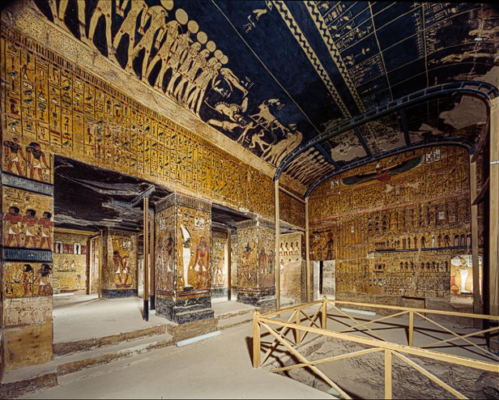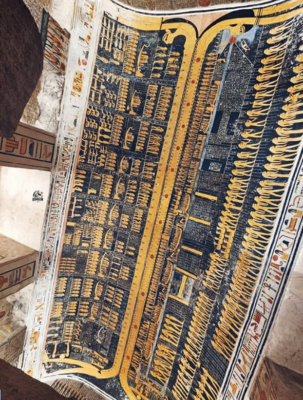The Tomb of Ramses V, designated as KV9, is one of the most fascinating and grandiose tombs in Egypt’s Valley of the Kings. Originally constructed for Ramses V and later completed by Ramses VI, this burial site is a testament to the artistic and religious depth of the New Kingdom. With its long corridors, intricate hieroglyphs, and vivid paintings, KV9 remains a must-visit for anyone intrigued by ancient Egyptian history and art.
The History and Construction of KV9
The Dual Legacy of Ramses V and Ramses VI
KV9 was initially intended to serve as the final resting place of Ramses V, the fourth pharaoh of the 20th Dynasty. However, after his death, his successor, Ramses VI, took over the tomb, expanded it, and made it his own burial chamber. This shared legacy makes KV9 unique compared to other royal tombs, as it reflects the artistic styles and religious influences of both rulers.
Architectural Design and Layout
One of the longest tombs in the Valley of the Kings, KV9 stretches approximately 117 meters. The structure consists of a descending corridor leading to multiple chambers, including a grand burial hall. Its design follows the traditional layout of New Kingdom royal tombs, with intricate carvings and celestial depictions adorning the walls. The tomb’s vast size and complex passages make it one of the most elaborate in the necropolis.

Artistic and Religious Symbolism in KV9
Magnificent Wall Decorations
The walls of KV9 are among the most beautifully preserved in the Valley of the Kings. Covered in hieroglyphs and colorful reliefs, the tomb showcases detailed scenes from sacred Egyptian texts. These include depictions from the Book of Gates, the Book of Caverns, and the Book of the Dead, which describe the pharaoh’s journey through the afterlife. The artistry in these paintings is remarkable, with vibrant colors and lifelike representations of gods, demons, and celestial beings.
The Burial Chamber and Celestial Imagery
The burial chamber is one of the most striking areas of KV9. Though it contains an unfinished pit, its ceiling features an awe-inspiring depiction of the sky goddess Nut. She is illustrated stretching across the heavens, symbolizing the cycle of day and night. Surrounding Nut are intricate scenes from the Book of the Day and the Book of the Night, which describe the sun’s journey across the sky and its renewal in the underworld. These celestial images reinforce the ancient Egyptian belief in rebirth and eternal life.
KV9’s Role in Ancient Egyptian Spirituality
The Journey to the Afterlife
Like other royal tombs in the Valley of the Kings, KV9 was built to ensure the safe passage of the pharaoh’s soul into the afterlife. The inscriptions and artwork serve as both a guide and a protective charm, helping Ramses V and Ramses VI navigate the underworld. The presence of various deities, including Osiris, Anubis, and Ra, highlights the spiritual significance of the tomb’s design.
Preservation and Modern Discoveries
Despite centuries of exposure and occasional looting, KV9 remains one of the best-preserved tombs in the necropolis. Archaeologists have conducted extensive studies on its structure, revealing hidden layers of ancient Egyptian beliefs. Modern technology, including 3D scanning, has helped restore some of the faded artwork, allowing scholars to gain deeper insights into its original splendor.

Visiting KV9: What to Expect
A Walk Through History
For visitors to the Valley of the Kings, exploring KV9 offers a truly immersive experience. Walking through its long corridors and vast chambers, one can witness firsthand the grandeur of ancient Egyptian burial practices. The vibrant murals and detailed inscriptions transport visitors back to a time when pharaohs ruled with divine authority.
Why KV9 is a Must-See
Unlike other tombs in the Valley, KV9 stands out for its extensive artwork, well-preserved inscriptions, and sheer scale. The dual occupancy by Ramses V and Ramses VI adds an extra layer of historical intrigue, making it a top destination for Egyptology enthusiasts. Whether you are an avid historian or a casual traveler, this tomb offers a breathtaking glimpse into the world of ancient Egyptian royalty.
Conclusion
The Tomb of Ramses V and Ramses VI is a magnificent site that showcases the artistic mastery and deep spiritual beliefs of ancient Egypt. From its long corridors to its celestial ceiling paintings, KV9 remains a highlight of the Valley of the Kings. A visit to this tomb is not just a journey into history but an opportunity to witness the enduring legacy of the pharaohs.

CÁC TIN KHÁC
Mary Walton: The Forgotten Inventor Who Helped Clean Up America’s Cities
Tomb of Queen Nefertari in the Valley of the Queens, Egypt
Discover the Hypostyle Hall of the Temple of Hathor at Dendera
Venus de Losange: Unveiling the Mystery of a 20,000-Year-Old Paleolithic Icon